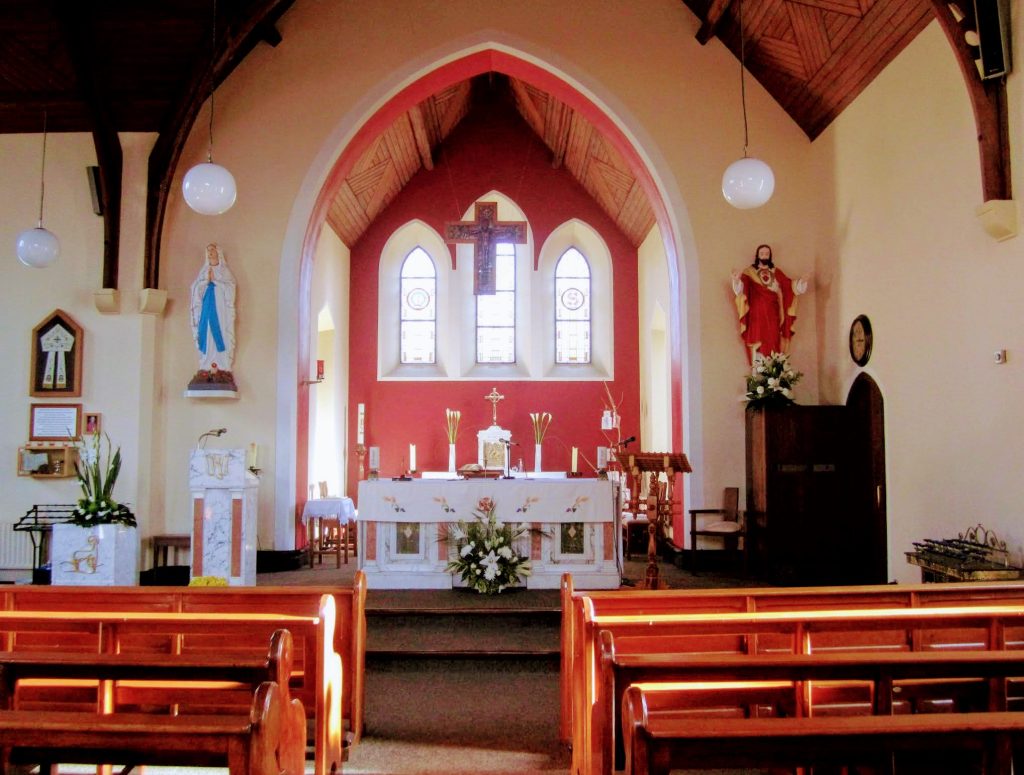Centenary Celebrations at the Church of St Brendan by the Lake, Annaghdown
By Martin Newell
This article first appeared in Anach Cuain 2006.
St Brendan’s was dedicated on 12 July 1903 by Archbishop Healy of Tuam who referred to it by the name shown above – presumanly to distinguish it from St Brendan’s, Corrandulla. The dedication ceremony was described in The Tuam Herald and The Galway Express of 18 July 1903. It was, to quote the Herald, “a ceremony of great stateliness and pomp”.
On 24 July 2003, there were centenary celebration ceremonies in St Brendan’s followed by a reception in Annaghdown school. A commemorative booklet was printed to mark the occasion – it includes the newspaper descriptions of 18 July 1903. The church ceremonies centered on Mass concelebrated by Canon Martin Newell, Parish Priest of Annaghdown, Fr Oliver McNamara, Curate of Annaghdown and Canon Michael Goaley – Parish Priest of Glenamaddy and a native of Annaghdown. A number of priests who had served in Annaghdown were present in the sanctuary.
Archbishop Michael Neary of Tuam presided and preached the sermon. He was accompanied by the guest of honour, Most Rev. Michael Courtney, Titular Archbishop of Eanach Dúin and Apostolic Nuncio in Burundi. There was a most impressive programme of instrumental, choir and solo music. The church was full and, for those present, the jewel of the entire occasion was an enthralling address by Archbishop Courtney after which he accepted a presentation of gifts from the Annaghdown community. The opportunity of the ceremonies was taken for Archbishop Neary to present the papal Benemerenti Medal to the family of the late Mrs Nora Duggan who had devoted much of her entire life to the care of St Brendan’s.
The ensuing reception in Annaghdown school was a heartwarming community celebration and a most convivial one. It afforded Archbishop Courtney an opportunity to meet the people of his Titular See. The occasion was much affected by the sudden illness of Christopher (Christy) Newell of Woodquay, Galway and formerly of Baranny, Annaghdown. Regrettably, Christy passed away on the following day. However, the unanimous sentiment was that, if forced to choose, he would have picked this occasion for his passing. Go ndéanfaidh Dia trócaire ar a anam.
The impression gained from the events of 24 July and from the preparations which preceded them was of a great outpouring of community spirit and neighbourliness. Such opportunities for coming together are now of the utmost importance. The people who attended the 1903 dedication were, of necessity, community-minded. At present, in the western world, we are in the era of the individual. The widespread availability of the television, the telephone and the motor car means that even next-door neighbours rarely meet face-to-face.
The occasion of a centenary always invites comparisons and contrasts. The period 1903 – 2003 is particularly interesting in this way. In terms of the material things in life, there can be no comparison between 1903 and 2003. The 20th century has been an extraordinary one by any standards. Its first half saw such a cataclysm of war and destruction as had never been known before. The second half, in Europe at least and based on the process of European union, brought standards of peace and prosperity which were hitherto unthinkable.
A church centenary naturally invites focus on ecclesiastical aspects of history. The years 1903 and 2003 can both be viewed as church watersheds in their own ways. In 1903 the Irish (Roman) Church was at the height of its development – one might say powers. The model structure, designed at the 1850 Synod of Thurles, was in place and functioning perfectly – as it continued to do for more than a further half-century. Now, under the exigencies of modern life, the structure is faced with disintegration and possible collapse. Much change was desirable, even essential, but in entering on a “new morality” we must remember the words of Hartley Shawcross, British prosecutor at the 1946 Nuremberg trials: “This so-called New Morality is merely the old immorality condoned”.
The centenary also provokes thoughts about the future, in this case particularly the year 2103. One could be over-pessimistic about the prospects for St Brendan’s and its community in that year. All species and institutions survive by change and adaptation to new environments. The institutional Church (particularly its Roman manifestation) is at a particular disadvantage in this regard. For its own reasons, it would have us believe that such processes do not apply to itself. In its own mind, it has always been and always will be the same. Such a view is entirely at variance with the facts of history. The greatest threat to the future of Christianity and the flourishing of Christian communities, such as that of Annaghdown, is that the institutional Church will succeed in preventing a relentless questioning of all but the most fundamental principle.
The ecclesiastical history of Annaghdown ought to provide encouraging evidence of how things change, develop and survive. Those who had the benefit of a Catholic schooling in the 1950s or before might have formed the facile view that the Pope sent St Patrick in 423 A.D. to make us all into good Roman Catholics, which we have been ever since despite the efforts of such as the English to destroy our faith. In fact, many scholars believe that the pre-Norman Irish Church was Eastern (or indeed Coptic) in origin, having come to us from the Alexandrian tradition which was very prominent in the early Church.
The very early monastic tradition in Ireland (of which Annaghdown is a great example) and some evidence of monophysite theology point towards Egypt. There is some irony in the fact that the Roman tradition was firmly founded in Ireland by an English king – Henry II – in the 12th century with Annaghdown becoming an important centre. Thereafter, the history of the Irish (Roman) Church could most charitably be described as turbulent with the only real semblance of order originating in the 16th century Council of Trent before structure and discipline were imposed in 1850. Having survived such change and upheval over fifteen centuries, there is every reason to hope that 2103 will see a vibrant Christian community in Annaghdown.
Further Reading
- Martin Newell: The Church of St Brendan by the Lake, Annaghdown, 1903-2003 – text of the commemorative booklet produced for the centenary.
- Martin Newell: Nobis Ministerium Reconciliationis (Ours is the Ministry of Reconciliation) – Reflections on Archbishop Courtney’s Visit, written following his assassination in December 2003; published in Anach Cuain 2006.
- Mary Forde (née Goaley): Was it the Communists? Annaghdown Church Fire, 1936, Anach Cuain 2004.



